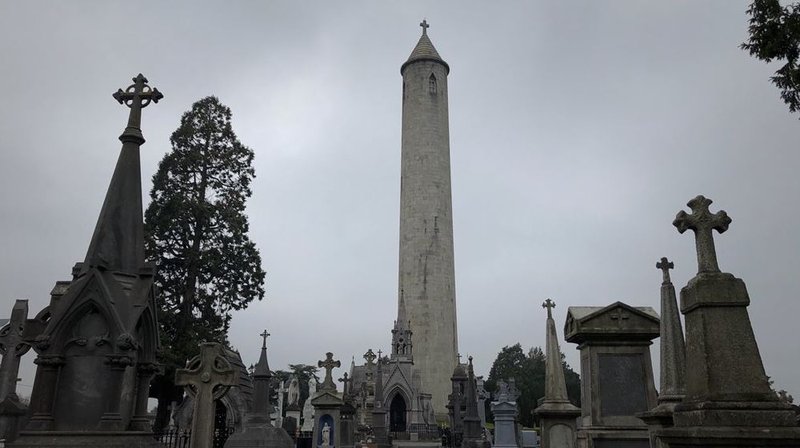O’Connell Tower in Glasnevin reopens 47 years after bomb blast
Posted By: April 14, 2018
The 55m (180.446 feet) structure affords the best man-made views of Dublin city
Ronan McGreevy. Irish Times. Fri, Apr 13, 2018

Glasnevin Cemetery’s O’Connell Tower, the tallest round tower in Ireland, has reopened to the public 47 years after a bomb damaged it structurally. Video: Ronan McGreevy
Share to FacebookShare to TwitterShare to Email App
When the O’Connell Tower at Glasnevin Cemetery was first opened in 1869, it was regarded as one of the wonders of the Victorian age.
At 55 meters ( 180.446 feet) in height over a huge vault containing the remains of Daniel O’Connell, the tower was one of the tallest man-made structures in the era before the skyscraper.
Built in honor of the Liberator, it was intended to convey the awakening of national pride, which followed Catholic Emancipation in 1829.
It was as a symbol of national identity that it was targeted by loyalist bombers in the early hours of Sunday, January 17th, 1971, in a petty act of spite following the blowing up of Nelson’s Pillar in 1966.
Ten pounds of high commercial explosive were placed at the bottom of the staircase to the tower. The explosion blew out every window in the tower, and the whole staircase came crashing down. The tower itself with its 1 meter thick(3.28084 feet) stone walls survived. The culprits were never found.
There it lay empty for the next 47 years because of a “lack of funds and a lack of interest,” admitted Glasnevin Trust chief executive George McCullough.
When he first arrived at the Glasnevin Trust in 1990, pigeon droppings littered the bottom of the tower as the birds could access the roof, the crypt was blocked off with concrete blocks, and the skylights were covered with plate steel so nobody could get another explosive device into the tower.
The crypt at the base of the tower containing O’Connell’s body was reopened in 1991, but it was not until 2013 before consideration was given to opening the tower itself.
The staircase was reproduced from a small watercolor drawing of the original and was cut at a workshop in Newland’s Cross before being transported to Glasnevin. All the steel supports had to be built specifically for the design. The process took nearly 18 months to come to fruition.
Before it could be opened to the public, it had pass health and safety tests and gain a fire certificate.
“We have a manual on this. It’s like four telephone books. It drove us crackers, but we got there,” Mr. McCullough said.
The tower is not for the faint-hearted or the unfit. There are 198 steps to the top, and none of them are easy, but the views from the top are worth the effort. On a clear day, you can see as far away as the Cooley Mountains and out to Ireland’s Eye.
Even with a gunmetal grey day in Dublin, there are panoramic views of the whole of Dublin. As Glasnevin is one of the highest points in Dublin, the tower affords the best man-made views of the city.
The tower was opened on Friday by the Minister for Finance and Public Expenditure, Paschal Donohoe, who said the Glasnevin Tower was the first thing he saw when he looked out his kitchen window in the morning.
He joked that if he could see out, others could see into his kitchen window from the tower and notice that the dishes were not washed.
Entry to the O’Connell Tower is a ticketed event only. Admission is €12.00 for adults and €9.00 for students (12-16 years), children (8 -12), and seniors.










